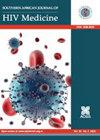博茨瓦纳青少年和年轻人自我报告的危险性行为
IF 1.6
4区 医学
Q4 INFECTIOUS DISEASES
引用次数: 4
摘要
青少年和年轻成人占全球人类免疫缺陷病毒(HIV)感染事件的三分之一以上。了解这一高危人群的性行为对于设计有针对性的艾滋病毒预防规划至关重要。目的描述来自博茨瓦纳30个社区的16-24岁青少年和年轻人自我报告的危险性行为。方法横断面、自我报告的初次性行为年龄;性伴侣数量;性行为中使用避孕套和酒精;代际性;并收集了交易性行为的数据。使用修正泊松估计方程获得单变量和多变量调整的患病率比(PR)和95%置信区间(CI),比较不同性别的不同性行为的参与度,说明研究的聚类设计。结果在3380名参与者中,2311人报告性活跃,女性报告性活跃的人数多于男性(分别为65%对35%;P < 0.0001)。在单变量分析中,女性参与者更有可能报告不一致的安全套使用情况(PR为1.61;95% CI 1.44-1.80),代际性别(PR 9.00;95% CI 5.84-13.88)和交易性(PR 3.46;95% CI 2.07-5.77)比男性少,但报告在15岁之前发生性行为的可能性更低(PR 0.59;95% CI: 0.41-0.85),在性交时使用酒精(PR: 0.59;95% CI 0.45-0.76)或在过去12个月内有≥2个伴侣(PR 0.65;95% ci 0.57-0.74)。博茨瓦纳青少年和年轻成人自我报告的危险性行为在男性和女性之间存在显著差异。针对不同性别的危险性行为突出了制定有针对性的艾滋病毒预防规划的重要性。本文章由计算机程序翻译,如有差异,请以英文原文为准。
Self-reported risky sexual practices among adolescents and young adults in Botswana
Background Adolescents and young adults account for more than one-third of incident Human Immunodeficiency Virus (HIV) infections globally. Understanding sexual practices of this high-risk group is critical in designing HIV targeted prevention programming. Objectives To describe self-reported risky sexual practices of adolescents and young adults aged 16–24 years from 30 Botswana communities. Methods Cross-sectional, self-reported age at sexual debut; number of sexual partners; condom and alcohol use during sex; intergenerational sex; and transactional sex data were collected. Modified Poisson estimating equations were used to obtain univariate and multivariate-adjusted prevalence ratios (PR) and 95% confidence intervals (CI) comparing engagement in different sexual practices according to gender, accounting for the clustered design of the study. Results Among the 3380 participants, 2311 reported being sexually active with more females reporting being sexually active compared to males (65% vs. 35%, respectively; p < 0.0001). In univariate analyses, female participants were more likely to report inconsistent condom use (PR 1.61; 95% CI 1.44–1.80), intergenerational sex (PR 9.00; 95% CI 5.84–13.88) and transactional sex (PR 3.46; 95% CI 2.07–5.77) than males, yet less likely to report engaging in sex before age 15 years (PR 0.59; 95% CI: 0.41–0.85), using alcohol around the time of intercourse (PR: 0.59; 95% CI 0.45–0.76) or having ≥ two partners in the last 12 months (PR 0.65; 95% CI 0.57–0.74). Conclusions Self-reported risky sexual practices of adolescents and young adults in Botswana differed significantly between males and females. Gender-specific risky sexual practices highlight the importance of developing tailored HIV prevention programming.
求助全文
通过发布文献求助,成功后即可免费获取论文全文。
去求助
来源期刊
CiteScore
2.80
自引率
11.80%
发文量
41
审稿时长
>12 weeks
期刊介绍:
The Southern African Journal of HIV Medicine is focused on HIV/AIDS treatment, prevention and related topics relevant to clinical and public health practice. The purpose of the journal is to disseminate original research results and to support high-level learning related to HIV Medicine. It publishes original research articles, editorials, case reports/case series, reviews of state-of-the-art clinical practice, and correspondence.

 求助内容:
求助内容: 应助结果提醒方式:
应助结果提醒方式:


